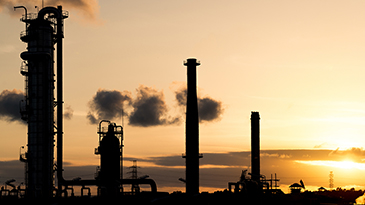Accurately predicting the behavior in acid gas removal systems can be challenging. These systems involve mass transfer, reaction and heat transfer, where traditional equilibrium stage models fall short. Rate-based models can overcome some of those limitations. At AspenTech, we developed the technology to handle systems with chemical reactions, and we further discretized the films to account for highly nonlinear profiles. The technology has evolved and improved over the course of 30 years to ensure a robust and complete solution.
Behind the scenes, the mathematical models consist of equations for material and energy balances, mass transfer and energy transfer, phase equilibrium, and so on. The size and nonlinearity of the equations make finding solutions difficult and time-consuming. Sometimes it could take a few tips and tricks to get to the solution. But fear not! Here are insights on how to troubleshoot an acid gas column when it is difficult to converge. This is the first of two blogs to walk you through some troubleshooting techniques. In this blog, we’ll focus on the first major step of the rate-based calculation: Initialization.
There are two options available in an acid gas column for the rate-based calculation, efficiency and advanced modeling, both based on our rate-based technology. The efficiency mode attempts to predict the Murphree efficiency of H2S and CO2 using rate-based principles in the context of equilibrium models. The advanced modeling mode uses the full rate-based technology to calculate the heat and mass transfer for each stage and for all components. With the full rate-based calculation, the two major steps are initialization and rate-based calculation. In the initialization calculation, an equilibrium-based approach creates initial estimates for temperature, flow and composition profile for the rate-based calculation.
Determining the Source of Convergence Failure
When a column fails to converge in advanced modeling mode, we need to determine where the convergence failure is occurring. To do so, on the parameters tab in the acid gas page, change the diagnostics level to medium to assess if the column converges during initialization. When you increase the diagnostic level, additional details appear in the trace window.
In the example shown here, the initialization step failed after 25 iterations and is unable to proceed to rate-based calculation.
Troubleshooting Initialization
If the initialization of the acid gas column fails in a situation where it generally succeeds (when the equilibrium-based solution is similar to that of the rate-based problem), there are a few common ways to improve the convergence. You can access most of the variables here by going to the advanced modeling convergence parameter then clicking the view button next to the convergence.
1. Increase Maximum Iterations
The default value for maximum iterations is 25, which is adequate in most cases. For more complex cases or in situations in which the error/tolerance continues to decrease but convergence is not achieved within 25 iterations, we recommend that you increase the maximum iterations value.
2. Adjust the Damping Level
For cases where error/tolerance oscillates near the solution, we can adjust the damping to stabilize the convergence. Since the convergence will take longer with additional iterations, we recommend using the mildest level that is effective to achieve convergence.
3. Provide Temperature Estimates
These estimates can be very useful in reaching the convergence, and we can specify them in the column parameters tab on the profiles page. For the bottom stage, overestimate a few Kelvin higher than the bottom stage feed stream. For the top stage in a reactive absorber, underestimate significantly - 20 – 50 Kelvin less than the top stage feed stream.
4. Modify the Holdup Estimates
The holdup estimate can be found under the advanced modeling convergence parameters. The liquid holdup estimate for the kinetic reaction is only used in initialization. Reaction holdup correlation and holdup scale factors are for the rate-based calculations. We will discuss these in part 2 of this blog. Often convergence issues can occur with faster reactions in the column. Thus, we can try a smaller liquid holdup estimate to obtain convergence in the initialization calculation, which again, serves as an initial estimate for the rate-based calculations.
Successfully getting the initialization calculation to converge allows the column to move onto the rate-based calculation with initial estimates. In the next blog, we will discuss some of the strategies to troubleshoot the rate-based calculations should those fail. We’ll also review specific strategies for the common solvents. In systems with MDEA, these strategies have helped the initialization to complete by specifying a top stage temperature that is 20 Kelvin below that of the top stage feed stream and a bottom stage temperature that is 1 Kelvin above that of the bottom stage feed stream.
Please check out the acid gas removal trial here if you have not used our acid gas and column functionalities. You can also view answers to the top 10 questions about our acid gas technology.



Leave A Comment